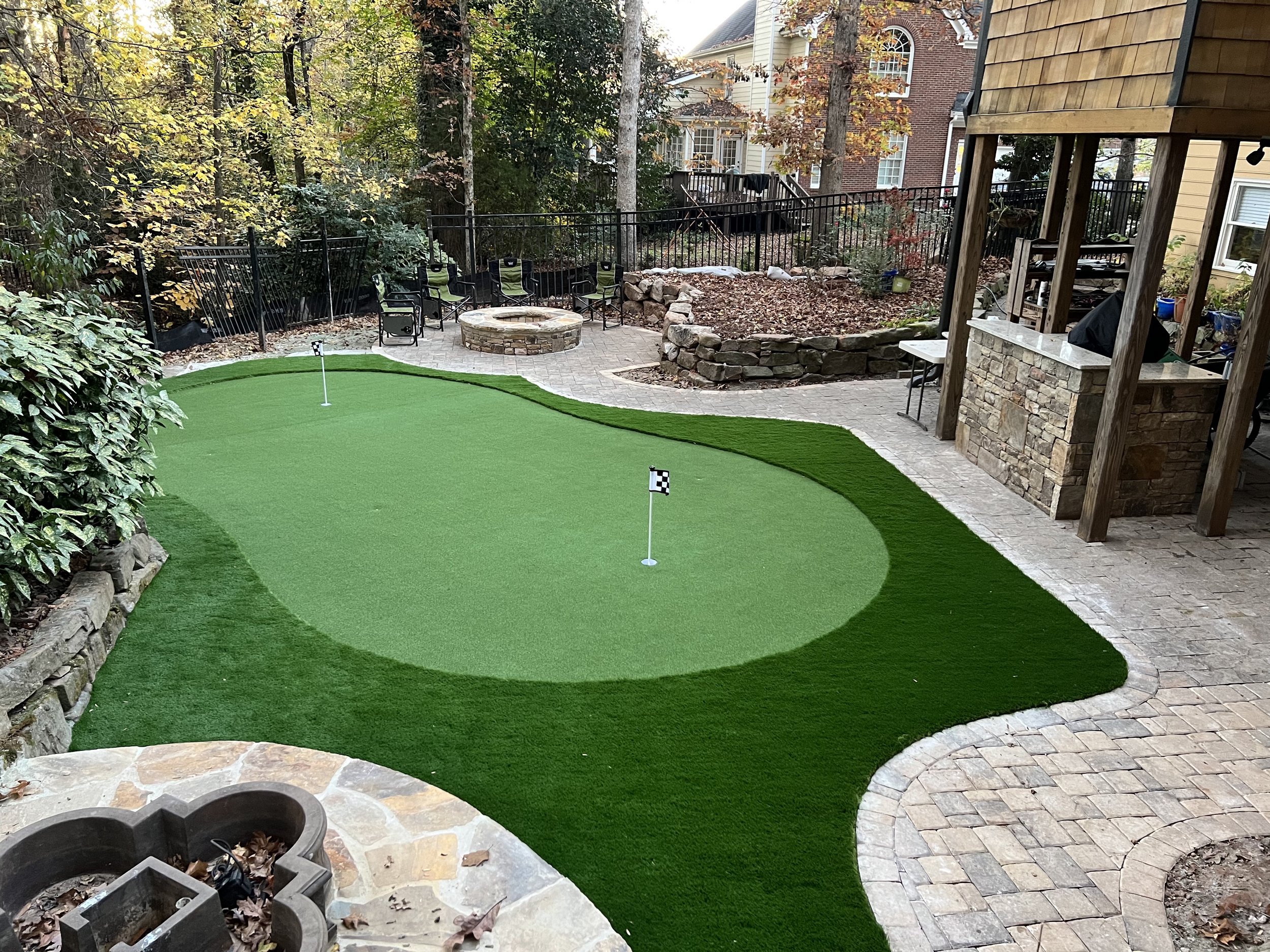
Installing a Backyard Putting Green
Putting Green Companion Podcast:
The Ideal Backyard for a (Synthetic) Green.
A backyard where nothing will grow.
For this particular homeowner in an older subdivision, the backyard was all shade and nothing grows. The project goal was to create a fully re-featured living space, centered around a very special addition. Waypoint Construction experts were tasked with creating a set up that didn’t need water or direct sunlight, where the homeowners don’t have to worry about maintenance.
A template outline for the putting green
With new pavers in place for the patio area, a template is laid down for the green using orange chalk. All the underground drainage is in place, which is very important. You DO NOT WANT water running over the surfaces and collecting on the synthetic turf.
Establishing the rough grade for the putting green.
A rough grade is established for the backyard putting green. White paint on the ground is set to replicate the slope at Sugar Loaf Country Club in North Georgia. The homeowner plays regular at the Sugar Loaf course, and this customization is a one of one. Chalking out the design, Waypoint builds over the design, similar to sculpture but in reverse.
Establishing the Fine Grade and Putting Radius.
Compacting the base for the green.
Using M10 fine grain sand, made of crushed rock that is typically granite, Waypoint’s crew makes a compacted base for the green. The Waypoint team can begin setting the fine grade.
Setting the radius of the putting green.
Stakes determine the radius of the putting green. Locate the stakes based on design to create the arcs. Just starting the fine grade. Team members raking sand on top of compacted base.
The project designer takes elevation shots to properly measure the grade. An insider trick: Use a golf ball to see how the ball rolls on the fine sand. This shows you how to set and adjust the breaks and curves.
Golf cups set and fine grade established.
The blue outline marks green, and then the cups are set. Global Syn-Turf provides all the golf equipment and elements. They bring the cups in, the pins. The artistic element on this project gets granular, and you can make fine adjustments to the finished project. In-house golf expert Rusk Jones personally designed the green to replicate shots at Sugar Loaf Country Club in Duluth, Georgia, based on existing knowledge of the course.
Making the Seams and Setting the Green.
Waypoint experts making a perfect seem on the green.
Determining the Seam: Turf is 15 feet wide to cover a 27 foot green. For certain, there will be one seam, and far more difficult to cut shapes than rectangles.
Chalking out the cuts on the green.
Using synthetic turf from our parters at Global Syn-Turf, the Waypoint experts cut the perfect seam to recreate the uninterrupted putting surface.
Two types of synthetic turf for an authentic green.
Two different kinds of turf are used for the putting green. The “border turf” outside the putting surface creates a more two-dimensional look. You work within the space limitations from the pavers and outdoor living space elements. With more available space, a third “fringe” turf can be added.
A Championship Result.
Embracing the use of a home as an entertainment space, this golf-enthusiasts backyard is completely transformed.
Now it can be used as a living space or private practice space for mastering the craft.
The Finished Product.
Green egg station, reshaped the flower bed, fire pit area.
Electrician came in, sleeved power sources applied to have lights in the living area. Fountain comes to life and runs full time.
Low Maintenance- If you have pet accidents on the turf, you can simply wash it off with dish soap and water (referenced in earlier podcast). Covers can be purchased for the golf cups, as well as a full turf cover. Remove the fall leaves with a blower, no need to rake. Change the flower beds seasonally to compliment the aesthetic.
The full array of waypoint construction group skills- Outdoor living space, synthetic turf, pavers. Paver walkway expands to wherever homeowner wants to travel through the patio/backyard area.
Goal of completely usable backyard space with low maintenance achieved.
Final Pro Thoughts.
Golf Question: To increase speed, add sand. The featured green naturally “stemps” at 9.5 - 10. Green silica sand is used in this case study.
Rules for turf:
Not much direct sunlight. Not a heat issue, BUT…
**REFLECTIONS FROM THE GLASS OF YOUR HOUSE CAN BURN A HOLE IN YOUR TURF.
Part of the homeowner process CAN BE tinting windows. Lawn turf companies do not warranty for sunlight burns.
Green synthetic, silica fill as opposed to river sand can help mitigate high temperatures.

